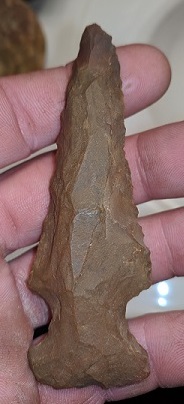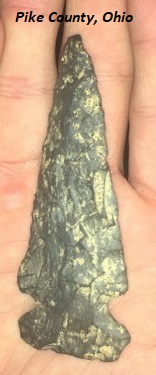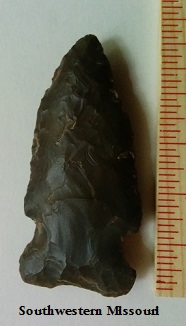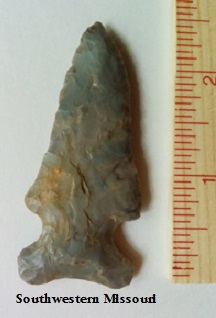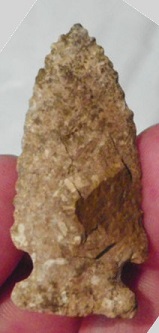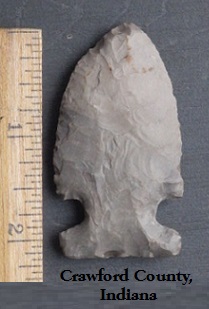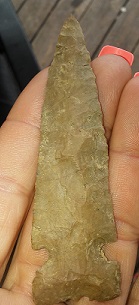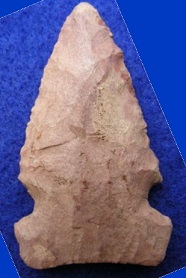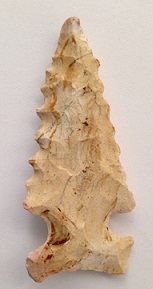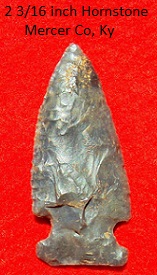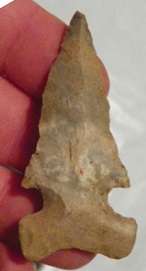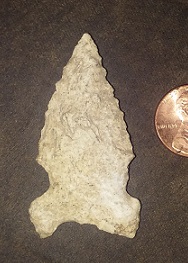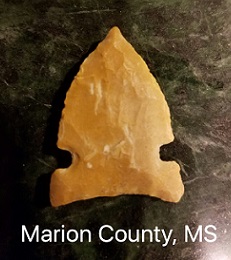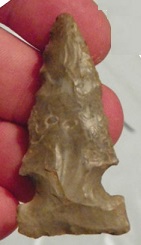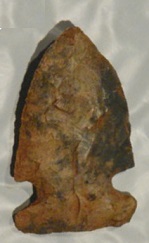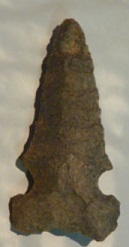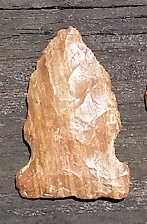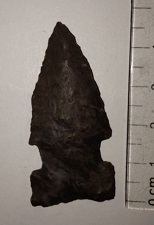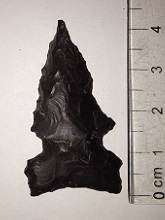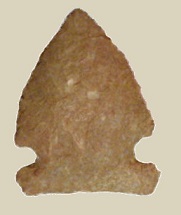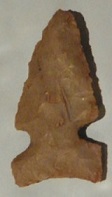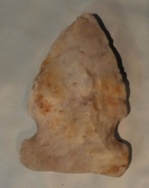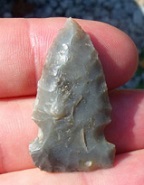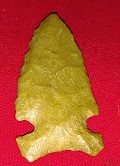Outline is Representative of Size and Shape:

Name Details:
Identified By: Madeline Kneberg
Named For: Big Sandy Early Archaic Phase I described by Thomas N. M. Lewis
Date Identified: 1956
Type Site: Big Sandy Site, Henry County, Tennessee
Identified By: Madeline Kneberg
Named For: Big Sandy Early Archaic Phase I described by Thomas N. M. Lewis
Date Identified: 1956
Type Site: Big Sandy Site, Henry County, Tennessee
Point Validity:
Valid type
Kneberg was a prominent anthropologist and professor at the University of Tennessee. She is most recognized for her excavations through-out the Tennessee River Valley. This type was named in a professional publication and has many professional references. This is considered a valid type.
Big Sandy Side Notch
Cluster: Large Side Notch Cluster Description of Physical Characteristics and Flaking Pattern:
This is a medium to large (typically 2.25 to 2.75 inches) triangular side notch point. The cross section is most commonly elliptical, but may also be flattened, rhomboid, or have a medial ridge. The blade can range from excurvate to straight and may be beveled or serrated. The shoulders are straight and the stem is expanded. Bases are most commonly straight, but may range from slightly convex to slightly concave. This point is made using primary percussion flaking with finishing pressure flaking along the edges. The most common flaking pattern is random, but some rare examples have had oblique transverse flaking.
Size Measurements:
Length - 35 to 80 mm (average 40 to 50 mm), Stem Length - 10 to 20 mm, Blade Width - 18 to 20 mm, Neck Width - 13 to 24 mm, Stem Width - Approximately the same as the shoulders, Thickness - 6 to 8 mm.
Length - 35 to 80 mm (average 40 to 50 mm), Stem Length - 10 to 20 mm, Blade Width - 18 to 20 mm, Neck Width - 13 to 24 mm, Stem Width - Approximately the same as the shoulders, Thickness - 6 to 8 mm.
Commonly Utilized Material:
Additional Comments:
Big Sandy are considered the earliest side notch point in the Side Notched Tradition. They overlap the Dalton points (W11).
There are three examples of the Big Sandy point. The early point is smaller and thought to be re-sharpened Graham Cave points. Middle points bases become rounder. Later points have longer stems and more articulated ears.
True Big Sandy points are Early Archaic points. Many people have included many other types in the "Big Sandy" classification. Many of these points are Middle to Late Archaic period points. These points include the types Godar and Raddatz. The earlier "true" Big Sandy points have a thin cross section with a less square base that is more eared with an incurvate base. They are commonly serrated (course to fine) with fine retouch flaking (W11).
Big Sandy are considered the earliest side notch point in the Side Notched Tradition. They overlap the Dalton points (W11).
There are three examples of the Big Sandy point. The early point is smaller and thought to be re-sharpened Graham Cave points. Middle points bases become rounder. Later points have longer stems and more articulated ears.
True Big Sandy points are Early Archaic points. Many people have included many other types in the "Big Sandy" classification. Many of these points are Middle to Late Archaic period points. These points include the types Godar and Raddatz. The earlier "true" Big Sandy points have a thin cross section with a less square base that is more eared with an incurvate base. They are commonly serrated (course to fine) with fine retouch flaking (W11).
Distribution: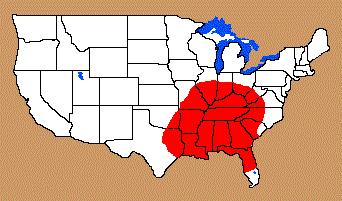
Distribution Comments:
These points are most abundant in the Tennessee River valley and has the second highest frequency in the Ohio River Valley. They are less common in the other highlighted areas.
These points are most abundant in the Tennessee River valley and has the second highest frequency in the Ohio River Valley. They are less common in the other highlighted areas.
Age / Periods:
Date: 10,000 - 8,000,B.P.
Cultural Period: Early Archaic
Glacial Period: Early Holocene
Culture:
Date: 10,000 - 8,000,B.P.
Cultural Period: Early Archaic
Glacial Period: Early Holocene
Culture:
Age Details:
This point is part of the Big Sandy Phase.
This point is part of the Big Sandy Phase.
Similar Points:
Black Sand, Bolen, Cache River, Ensor, Fairland, Frio, Godar, Graham Cave, Hickory Ridge, Kessell, Newton Falls, Osceola, Raddatz, Rowan, Savage Cave, Taylor Side Notch
Black Sand, Bolen, Cache River, Ensor, Fairland, Frio, Godar, Graham Cave, Hickory Ridge, Kessell, Newton Falls, Osceola, Raddatz, Rowan, Savage Cave, Taylor Side Notch
Other points in this cluster / Related / Associated Points:
Big Sandy Broad Base, Big Sandy Constricted Base, Big Sandy Leighton Base, Big Sandy E-Notch, Cache River Godar, Graham Cave, Greenbrier, Hemphill, Howard County, Madison Side Notched, Osceola, Osceola Greenbrier, Raddatz, Simonsen
Big Sandy Broad Base, Big Sandy Constricted Base, Big Sandy Leighton Base, Big Sandy E-Notch, Cache River Godar, Graham Cave, Greenbrier, Hemphill, Howard County, Madison Side Notched, Osceola, Osceola Greenbrier, Raddatz, Simonsen

